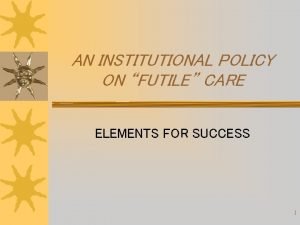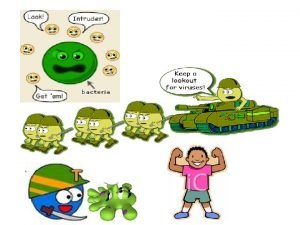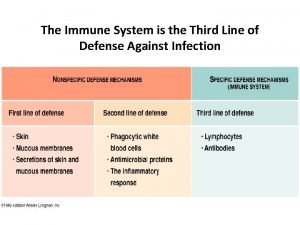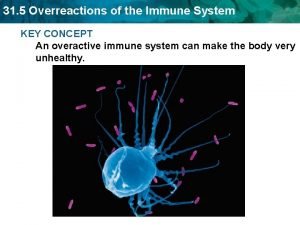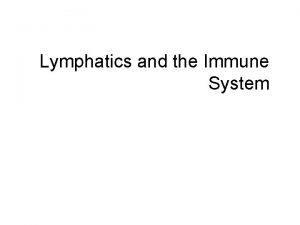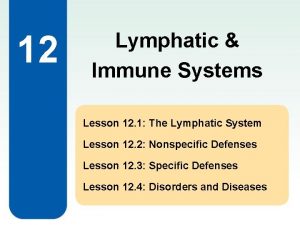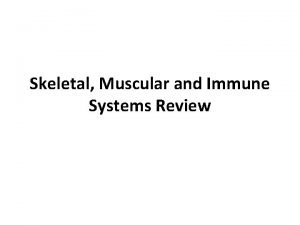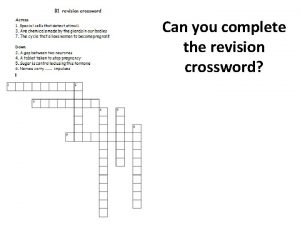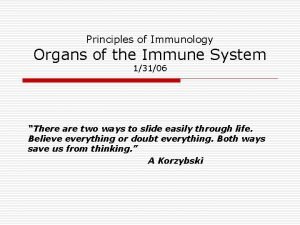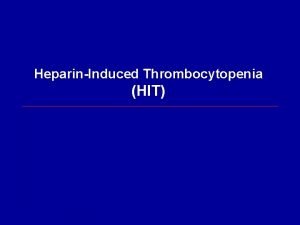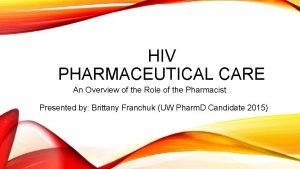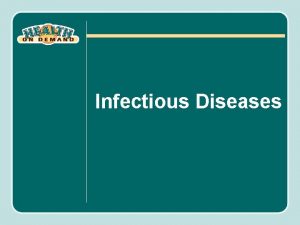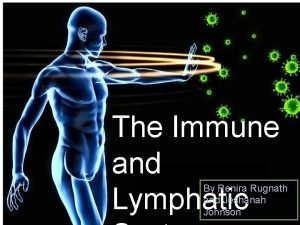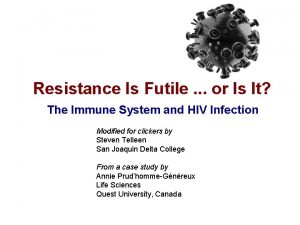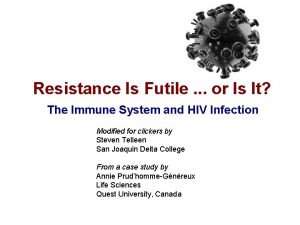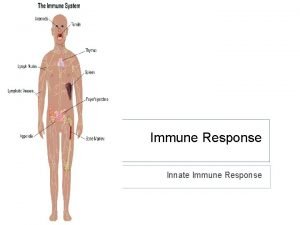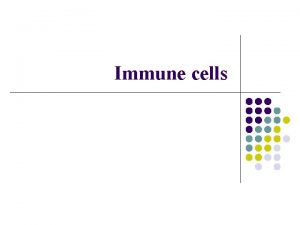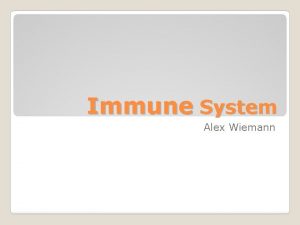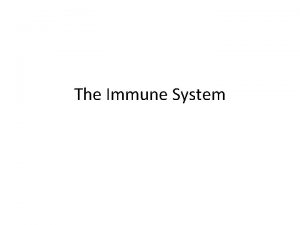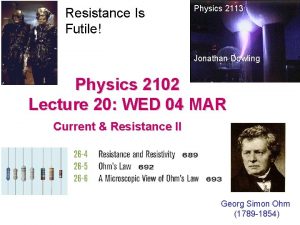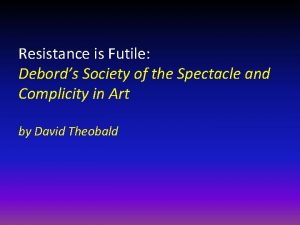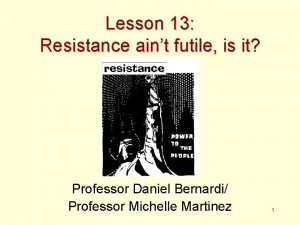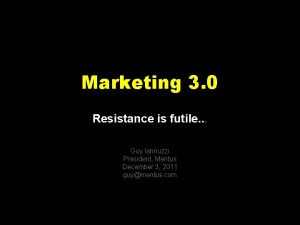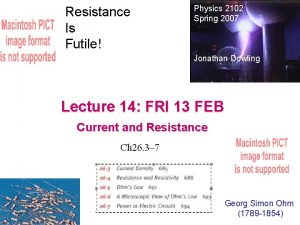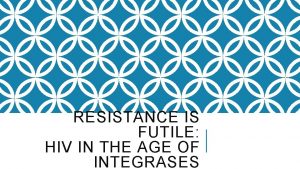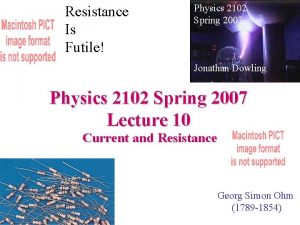Resistance Is Futile or Is It The Immune




























- Slides: 28

Resistance Is Futile. . . or Is It? The Immune System and HIV Infection Modified for clickers by Steven Telleen San Joaquin Delta College From a case study by Annie Prud’homme-Généreux Life Sciences Quest University, Canada

Resistance is futile … The Immune System and HIV § The vast majority of people are susceptible to HIV infection. § However, in the 1990 s, several individuals noticed that despite repeated exposure to the HIV virus they remained HIV negative. § Were these individuals extremely lucky? § Was something different about them that made HIV infection less likely? § William Paxton and his colleagues became interested in this phenomenon of HIV protection. § We will retrace the steps and experiments that these researchers performed to understand the mechanism underlying the protection against HIV (Paxton et al. , 1996) § First, let us review a few facts about the HIV virus, the immune system, and HIV infection

Resistance is futile … The Immune System and HIV § The HIV Virus § Is spherical in shape § HIV encodes its 9 genes using the nucleic acid molecule RNA § The virus particle also contains proteins important for replication § § Reverse transcriptase Integrase Protease Ribonuclease § The HIV virus is enclosed by multiple layers § Capsid the outer protein coat made of the protein p 24 § The level of p 24 protein is an indicator of the amount of HIV virus in the blood § The capsid is wrapped in a double layer of phospholipids § Proteins stick out of the lipid layer, perhaps most important gp 120 (Env) § The gp 120 protein gives HIV its specificity: § gp 120 interacts with specific proteins allowing the virus to infect specific human cell types

Resistance is futile … The Immune System and HIV § Immune System Review § Lymphocytes are immune cells that attack foreign particles (antigens) in the body § B cells § Secrete antibody into the circulatory system § Antibody binds to a specific antigen § Antibodies neutralize their target § Cytotoxic T cells (TC, Tkiller or CD 8+) § Kill cells that have already been infected § Have the CD 8 protein on their cell surface § T Helper cells (TH or CD 4+) § Coordinate the action of TC cells and B cells § Have the CD 4 protein on their cell surface

Resistance is futile … The Immune System and HIV § HIV Infection § HIV targets and infects TH cells § The HIV gp 120 protein recognizes and binds to the TH CD 4+ protein § HIV is a retrovirus § § It has to convert its RNA genome to DNA § Reverse transcriptase makes DNA copies of the RNA virus § Integrase integrates the converted DNA into the cell’s DNA The 9 HIV genes hijack the cell’s machinery § Produce all the proteins and RNA needed to make more virus particles § Newly-made virus particles bud off of the T helper cell § It now is a virus-producing factory

Resistance is futile … The Immune System and HIV Clicker Question 1 Which of the following is true of lymphocytes? A. B cells directly destroy invaders in the blood and body fluids B. Individual B-cells can produce antibodies for multiple antigens C. TH cells activate both TC cells and B cells D. TC cells destroy invading microbes

Resistance is futile … The Immune System and HIV Clicker Question 2 How is a retrovirus different from other viruses? A. It must convert its RNA to DNA and integrate its genome with the host DNA B. It avoids recognition by reverting to an earlier version of its genome C. It undergoes mutations in the host to avoid detection D. It only targets CD 4 receptors on the host cell

Resistance is futile … The Immune System and HIV Clicker Question 3 Why are most body cells other than TH cells not targeted by the HIV virus? A. Other cells are not as critical to overall immunity B. Most other cells do not have CD 4 receptors on their surface C. HIV can only attach to cells with CD 8 receptors D. Other cells do not contain reverse transcriptase

Resistance is futile … The Immune System and HIV In groups of two or three, come up with as many hypotheses as you can to explain why some individuals might be protected against HIV infection. To get there: § Discuss how the immune system fights viral infection. § Discuss how HIV infects cells and reproduces.

Resistance is futile … The Immune System and HIV § Two hypotheses proposed by Paxton and colleagues: § “Super Cytotoxic T Cells” Hypothesis (CD 8+ lymphocyte inhibition) § TC cells of the protected individuals were better and faster at recognizing infected TH cells § Infected TH cells are destroyed before the virus can replicate § Therefore they are not transformed into HIV factories § “Super T Helper Cells” Hypothesis (CD 4+ infectibility and replication efficiency) § TH cells of the protected individuals were different, preventing the infection and replication of the virus § There are many steps necessary for viral infection and replication § Any of them could be impeded.

Resistance is futile … The Immune System and HIV § Back to your group § Classify each of your proposed hypotheses into the two categories proposed by Paxton and his colleagues: § Super Cytotoxic T Cells” Hypothesis § Super T Helper Cells” Hypothesis § Note: some hypotheses may fit into neither category § How might you test your hypotheses? § Propose an experiment for one of your hypotheses. § How will you set up the experiment? § What will you measure (specific data you will collect)? § What are your controls?

Resistance is futile … The Immune System and HIV § Paxton and his colleagues recruited 25 volunteers § who claimed to have had repeated exposure to the HIV virus and yet were not infected with HIV § They also recruited 9 individuals § Not exposed to the HIV virus (and who tested negative for the virus) § This latter group is the control, whose response to HIV should be the same as the response of the majority of people

Resistance is futile … The Immune System and HIV § They isolated TH cells and TC cells from individuals in each group. They then performed the following experiments: § In one tube, they mixed HIV virus and T helper cells § In another tube, they mixed HIV virus, T helper cells, and cytotoxic T cells § They monitored the accumulation of virus in the test tube over time by measuring the amount of p 24 proteins produced § Why does the p 24 indicate the accumulation of HIV virus? § Why was one of the tubes not just HIV virus & cytotoxic T cells?

Resistance is futile … The Immune System and HIV What would the possible outcomes for this experiment look like? Draw three X Y graphs as shown below. What would expected results look like for a: § Protected individual, assuming that the “Super Cytotoxic T Cells” Hypothesis is correct. § Protected individual, assuming that the “Super T Helper Cells” Hypothesis is correct. Note that each graph requires two lines (the two test tubes).

Resistance is futile … The Immune System and HIV Clicker Question 4 If your results for the resistant group look like those on the right, which hypothesis is supported? NOTE: You should be able to quickly match this to one of your possible outcomes from the previous exercise! A. The Super Cytotoxic T Cells Hypothesis B. The Super T Helper Cells Hypothesis C. Neither hypothesis is supported

Resistance is futile … The Immune System and HIV Paxton’s Results § The top graph data (a) come from control individuals § The bottom graph data (b) come from 10 people claiming to be protected against HIV infection LP = Leukopac Preparation (random blood donors) EU = Exposed Unaffected

Resistance is futile … The Immune System and HIV Clicker Question 5 Do cytotoxic T cells provide protection from HIV in control individuals? A. Yes B. No C. Sometimes

Resistance is futile … The Immune System and HIV Clicker Question 6 Do any individuals in the “protected” group appear to be protected from HIV? A. Yes B. No

Resistance is futile … The Immune System and HIV § Back to your group § Try to identify patterns in the results of the protected individuals? § Can you group the individual experimental results into categories? § If so, how many? § Classify each subject into the different categories

Resistance is futile … The Immune System and HIV Clicker Question 7 Which of Paxton’s hypotheses seem to be validated by the results of the protected individuals? A. The Super Cytotoxic T Cells Hypothesis B. The Super T Helper Cells Hypothesis C. Neither hypothesis is supported D. Both, the results are mixed

Resistance is futile … The Immune System and HIV § Paxton’s team was particularly interested in protected subjects EU 2 and EU 3 and in investigating the mechanism of action of their protection against HIV § HIV-1, the most common form of the virus and the one responsible for the pandemic, can be classified into two different types: § M-tropic (also called non-syncitia-inducing (NSI) or R 5 HIV-1) strains § Must bind to two cell surface proteins to enter and infect a cell: § CD 4 protein § Beta-chemokine receptor CCR 5 § T-tropic (also called syncitia-inducing (SI) or X 4 HIV-1) strains § Must bind to slightly different proteins to enter and infect a cell: § CD 4 protein § Alpha-chemokine receptor CXCR 4 (at the time called fusin)

Resistance is futile … The Immune System and HIV § Let’s assume that compared to controls, protected individuals have one of the following mutations § CCR 5 protein (M-tropic gene mutation) § CXCR 4 protein (T-tropic gene mutation) § What would the possible outcomes for this experiment look like? § Draw graphs like those below and show what results for each would look like § Remember that each graph should have two lines, and review which proteins are required for infection by the two strains

Resistance is futile … The Immune System and HIV Clicker Question 8 The results on the right indicate a mutation in which protein of protected individuals? A. CCR 5 protein B. CXCR 4 protein

Resistance is futile … The Immune System and HIV Clicker Question 9 Which strain(s) of HIV-1 can infect and replicate in the TH cells of protected individuals? A. T-tropic B. M-tropic § Filled circles ( • ) represent TH cells from controls, § Empty circles (º) represent TH cells from protected individuals. § Letters and numbers above each graph show the name of the HIV-1 strain used in the experiment.

Resistance is futile … The Immune System and HIV § The M-strain HIV-1 is the infectious agent 90% of the time in sexually transmitted HIV (Ahmad, 2002) § CD 4 and CCR 5 proteins are used by HIV to gain entry into the TH cell § Most of the individuals resistant through a “Super TH Cell” mechanism harbor the same mutation making their CCR 5 gene non-functional § Recent studies have shown that individuals homozygous for the CCR 5 mutation are more prone to West Nile Virus infection and possibly hepatitis § The mutation is found predominantly in populations of European descent § 1– 3% homozygous, 14% heterozygous, 83% homozygous non-mutated § It is first thought to have appeared in the population around 700 years ago § Suggested hypotheses for the mutation frequency include: § Conferring resistance to Yersinia pestis, the infectious agent of the bubonic plague § Conferring resistance to smallpox § Neutral evolution

Resistance is futile … The Immune System and HIV § Back to your group § It is a relatively simple procedure to test the genotype of a person at the CCR 5 gene to determine whether they have the CCR 5Δ 32 mutation. § What are the arguments for and against genotype testing of the CCR 5 gene? § Discuss it in your group

Resistance is futile … The Immune System and HIV Clicker Question 10 Should a person wishing to have their genotype tested to determine whether they have the CCR 5Δ 32 mutation be allowed to do so? A. Yes B. No

Resistance is futile … The Immune System and HIV Image Credits Except as noted below, images appearing in this presentation are the creation of Annie Prud’homme-Généreux from the original version of this case and are reused with the permission of NCCSTS. Slide 1: Image of HIV virus in title block ©Sebastian Kaulitzki | Dreamstime. com. Slides 16, 17, 18, 19, 20, and 24: Figures take from: Paxton, W. A. , Martin, S. R. , Tse, D. , O’Brien, T. R. , Skurnick, J. , Van. Devanter, N. L. , Padian, N. , Braun, J. F. , Kotler, D. P. , Wolinsky, S. M. , Koup, R. A. (1996). Relative resistance to HIV-1 infection of CD 4 lymphocytes from persons who remain uninfected despite multiple high-risk sexual exposures. Nature Medicine 2(4): 412– 417. Reused with permission of Macmillan Publishers Ltd: Nature Medicine, copyright 1996. 28
 A subsequent
A subsequent Dimension of resistance
Dimension of resistance Chapter 26 the futile search for stability
Chapter 26 the futile search for stability Chose futile
Chose futile After hours of futile debate
After hours of futile debate What does indolent mean in the most dangerous game
What does indolent mean in the most dangerous game Define futile care
Define futile care Specific cake resistance and filter medium resistance
Specific cake resistance and filter medium resistance Force of air resistance
Force of air resistance Tdmu
Tdmu Body third line of defense
Body third line of defense Immunity classification
Immunity classification The first line of defense
The first line of defense Overreactions of the immune system
Overreactions of the immune system What is the third line of defense in the immune system
What is the third line of defense in the immune system Lymph return
Lymph return Lesson 12 blood and immune system
Lesson 12 blood and immune system Type of muscle
Type of muscle Biosimilar study
Biosimilar study Tonsil
Tonsil Active artificial immunity
Active artificial immunity Immune response controller crossword
Immune response controller crossword Oobean
Oobean Ap bio immune system
Ap bio immune system Heparin induced thrombocytopenia
Heparin induced thrombocytopenia Immune reconstitution therapy
Immune reconstitution therapy Immune
Immune Defination of immune system
Defination of immune system Lymphatic vs immune system
Lymphatic vs immune system






